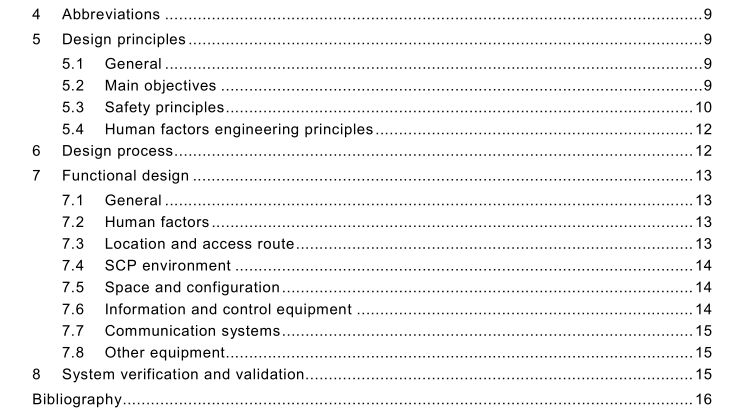BS IEC 60965:2009 pdf download – Nuclear power plants — Control rooms — Supplementary control points for reactor shutdown without access to the main control room
7 Functional design
7.1 General Because of the low frequency of use and the relatively small number of tasks which need to be performed in the SCP, the design shall aim to achieve a minimum extent of equipment, high reliability of functions and a configuration for easy and quick understanding.
7.2 Human factors Anthropometric considerations, population stereotypes, intensity of audible signals, visual and viewing angles as well as preference for analogue or digital indications shall be chosen consistently with those for the MCR. An adequate level of illumination shall be provided to ensure that visibility is sufficient for task performance on a continuous basis without undue fatigue.
The auditory environment shall enable clear verbal communication to be held. If working areas are provided for use over an extended time, means for adequate seated operation, writing and document reference and document lay down should be provided. If computer based information or control is used at the SCP, these shall function in a manner closely matching and preferably in an identical way to that of similar controls and indications in the MCR. Reliability and environmental considerations may require different equipment, but corresponding and compatible operating sequences to those in the MCR shall be used.
7.3 Location and access route
The location of the SCP shall be chosen and the protection shall be designed so that no sequence of events of any PIE can simultaneously affect the functions of both the SCP and the MCR.
This should include consideration of events that might affect them either directly or by affecting the service systems that support the SCP and MCR, respectively.
Fire is an important hazard following which use of the SCP may be required, and an assessment of the fire protection of the SCP and the human routes to them should be made and should show accessibility to the SCP location. Similar assessments of all service systems, with special reference to heating, ventilation and air conditioning systems, access routes and cables, should be made for other design basis conditions for which the SCPs are to be used. The assessment of the cable routes should demonstrate independence of the SCP cables from the MCR cables.
It shall be possible to reach the SCP easily, safely and within the time allowed, notwithstanding the need for access control. This shall be possible both from the MCR upon its evacuation and by routes avoiding the MCR and avoiding any other areas potentially affected by hazards following which use of the SCP is required. An indication of the potential hazards (e.g. fire) and suitable countermeasures (e.g. breathing equipment) should be provided along the access route from the MCR to the SCP. Before an SCP is to be accessed, it shall be possible for the operating staff to be assured that the environment is safe for their access. In order to alert all operating staff, particularly those who were off site when the MCR was abandoned, it shall be clearly indicated that the MCR is unavailable and shall not be accessed for control purposes until it is available again.
7.4 SCP environment The environmental conditions at the SCP shall meet the requirements derived from the safety analysis for normal and emergency conditions and shall take into account national rules, including the security plan in the respective country. For the design basis conditions requiring use of the SCP, the environmental conditions shown by the safety analysis for the intended location of an SCP shall not exceed those for normal unprotected human access. Where an SCP may be required for use in a beyond design basis or severe accident condition, involving the national security plan, the location should be shown to be suitable for normal human access in those conditions.
A battery powered emergency lighting system shall be continuously available even upon failure of the normal system. The emergency system should provide sufficient illumination for task performance on the basis of a limited operational period, which should be shown to meet the requirements of the plant emergency plan.
